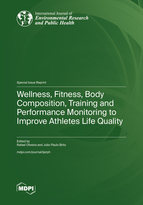Wellness, Fitness, Body Composition, Training and Performance Monitoring to Improve Athletes Life Quality
A special issue of International Journal of Environmental Research and Public Health (ISSN 1660-4601). This special issue belongs to the section "Sport and Health".
Deadline for manuscript submissions: closed (30 April 2023) | Viewed by 23063
Special Issue Editors
2. Life Quality Research Center, 2040-413 Rio Maior, Portugal
3. Research Centre in Sport Sciences, Health Sciences and Human Development, 5001-801 Vila Real, Portugal
Interests: exercise physiology; soccer training, well-being, training load; sports; physical activity and healthy lifestyle; exercise training programs; physical capacity; body composition; strength and conditioning
Special Issues, Collections and Topics in MDPI journals
2. Life Quality Research Center, 2040-413 Rio Maior, Portugal
3. Research Centre in Sport Sciences, Health Sciences and Human Development, 5001-801 Vila Real, Portugal
Interests: exercise physiology; clinical exercise physiology; exercise training programs; well-being, physical activity and healthy lifestyle; assessment of physical capacity; quality of life of subjects with clinical conditions and active lifestyle (elderly, children, type 2 diabetes, Parkinson, etc.); sarcopenia; osteopenia; osteoporosis; fall prevention; body composition; strength and conditioning; soccer training; load monitoring; sports
Special Issues, Collections and Topics in MDPI journals
Special Issue Information
Dear Colleagues,
Several studies on training and match load quantification; well-being; as well as fitness and body composition can be found in the literature, especially in soccer with male athletes. However, there are many other sports that intend to produce knowledge on these topics that also deserve merit. In addition, more studies should include women athletes instead of only men.
Although some studies have already been produced, the present Special Issue prioritizes research focusing on the understanding of how training and match monitoring can help to improve athlete quality of life. Therefore, we suggest that authors include wellness, health, fitness, and body composition variables in their studies. In addition, we welcome studies that analyze the relationship of exercise training programs and usual training/match measures such as total distance, distances at different threshold speeds, sprints, acceleration, deceleration, player load, metabolic power, session rated perceived exertion, heart rate, and others. Moreover, original designs that include the analysis of contextual factors (e.g., match location, match results, quality of opponents, match/season periods, and others) are welcome as they provide new knowledge on athlete quality of life.
Therefore, the aim of this Special Issue is to provide new and updated knowledge on wellness, fitness, body composition, training, and performance monitoring and how they can be used to improve athlete quality of life.
We believe that this Special Issue will provide relevant information for several sports in order to apply better strategies to the training process, helping athletes to win competitions and improve or maintain their quality of life.
Dr. Rafael Oliveira
Dr. João Paulo Brito
Guest Editors
Manuscript Submission Information
Manuscripts should be submitted online at www.mdpi.com by registering and logging in to this website. Once you are registered, click here to go to the submission form. Manuscripts can be submitted until the deadline. All submissions that pass pre-check are peer-reviewed. Accepted papers will be published continuously in the journal (as soon as accepted) and will be listed together on the special issue website. Research articles, review articles as well as short communications are invited. For planned papers, a title and short abstract (about 100 words) can be sent to the Editorial Office for announcement on this website.
Submitted manuscripts should not have been published previously, nor be under consideration for publication elsewhere (except conference proceedings papers). All manuscripts are thoroughly refereed through a single-blind peer-review process. A guide for authors and other relevant information for submission of manuscripts is available on the Instructions for Authors page. International Journal of Environmental Research and Public Health is an international peer-reviewed open access monthly journal published by MDPI.
Please visit the Instructions for Authors page before submitting a manuscript. The Article Processing Charge (APC) for publication in this open access journal is 2500 CHF (Swiss Francs). Submitted papers should be well formatted and use good English. Authors may use MDPI's English editing service prior to publication or during author revisions.
Keywords
- male athletes
- female athletes
- exercise training programs
- body composition
- sports training
- sports performance
- fitness
- wellness
- training load
- contextual variables
- quality of life







